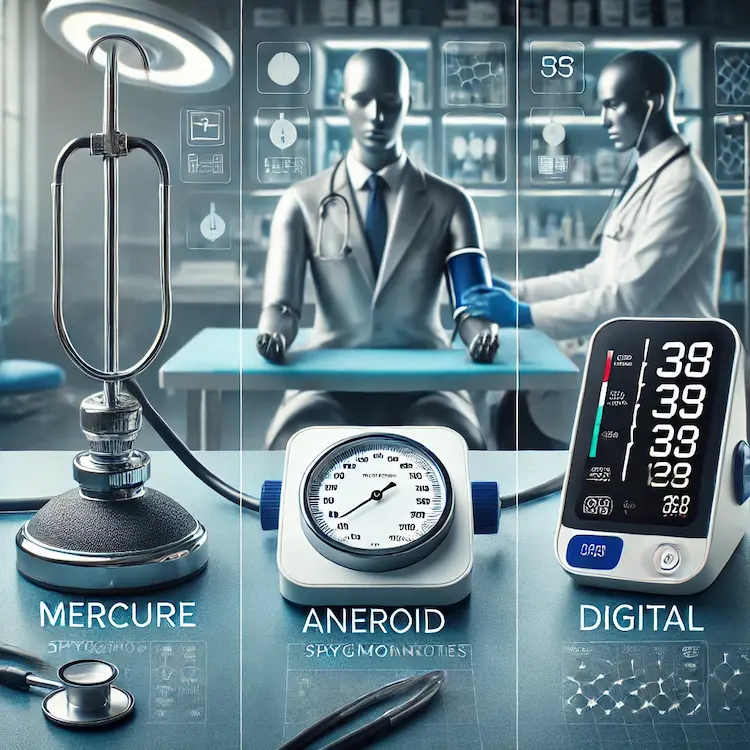Blood pressure is one of the most critical health indicators, and the sphygmomanometer is the primary tool used to measure it. However, for many people, the readings provided by this device – typically shown as two numbers – remain a mystery. Understanding what these numbers truly mean is vital for managing cardiovascular health and preventing serious conditions like hypertension, stroke, or heart attacks. This article breaks down the meaning behind sphygmomanometer readings, explains why they matter, compares different methods and devices, and offers practical tips for managing and interpreting your blood pressure data.
What is a Sphygmomanometer?
A sphygmomanometer is a medical instrument used to measure blood pressure. It consists of three key components:
- Inflatable Cuff – Wraps around the upper arm or wrist and restricts blood flow when inflated.
- Pressure Gauge – Measures the pressure inside the cuff.
- Stethoscope (in manual versions) – Used to listen to arterial sounds (Korotkoff sounds) when blood begins to flow again.
There are two main types:
- Manual Sphygmomanometer (Aneroid or Mercury) – Requires trained personnel.
- Digital Sphygmomanometer – Common for home use.

Understanding the Two Key Numbers
1. Systolic Pressure (Top Number)
This number represents the pressure exerted on artery walls when the heart contracts and pumps blood into the arteries.
- Normal Range: 90-120 mmHg
- Elevated: Above 120 mmHg
- Hypertension Stage 1: 130-139 mmHg
- Hypertension Stage 2: 140 mmHg and above
2. Diastolic Pressure (Bottom Number)
This represents the pressure in the arteries when the heart rests between beats.
- Normal Range: 60-80 mmHg
- Elevated: Above 80 mmHg
- Hypertension Stage 1: 80-89 mmHg
- Hypertension Stage 2: 90 mmHg and above
Combined Interpretation
| Blood Pressure Category |
Systolic (mmHg) |
Diastolic (mmHg) |
| Normal |
<120 |
<80 |
| Elevated |
120-129 |
<80 |
| Hypertension Stage 1 |
130-139 |
80-89 |
| Hypertension Stage 2 |
≥140 |
≥90 |
| Hypertensive Crisis |
>180 |
>120 |
Why These Numbers Matter
Predicting Cardiovascular Risk
According to the World Health Organization, high blood pressure is responsible for approximately 13% of global deaths annually, highlighting the importance of accurate readings.
Monitoring Lifestyle Impact
Diet, exercise, and stress management directly impact both systolic and diastolic readings. Tracking trends over time helps individuals see how lifestyle changes influence heart health.
Identifying Hidden Health Issues
Persistently low readings can signal underlying problems such as internal bleeding, endocrine disorders, or severe infections.
Types of Sphygmomanometers and Their Accuracy
1. Mercury Sphygmomanometer
- Considered the Gold Standard for accuracy.
- Typically used in clinical settings.
- Requires calibration and skilled use.
2. Aneroid Sphygmomanometer
- Portable and durable.
- Requires manual inflation and stethoscope use.
- Prone to calibration drift if not maintained.
3. Digital Sphygmomanometer
- Common in home monitoring.
- Provides automatic readings.
- May lose accuracy over time or if improperly fitted.
| Type |
Accuracy |
Ease of Use |
Suitability |
| Mercury |
Very High |
Low |
Hospitals, Clinics |
| Aneroid |
High (if calibrated) |
Moderate |
Medical Offices, Home (trained users) |
| Digital |
Moderate to High |
Very High |
Home Use |
Oscillometric vs Auscultatory Methods
Auscultatory (Manual Devices)
- Detect Korotkoff sounds with a stethoscope.
- More accurate if performed correctly.
- Requires trained personnel.
Oscillometric (Digital Devices)
- Detect artery oscillations during cuff deflation.
- Easier but may be less accurate in certain conditions (e.g., irregular heartbeat).
| Method |
Accuracy |
Complexity |
Use Case |
| Auscultatory |
Very High |
High |
Clinical Settings |
| Oscillometric |
Moderate to High |
Low |
Home Monitoring |
Common Factors Affecting Readings
| Factor |
Effect on Reading |
| Cuff Size |
Too small: Overestimates BP
Too large: Underestimates BP |
| Arm Position |
Below heart level: Overestimates BP
Above heart level: Underestimates BP |
| Recent Activity |
Raises systolic readings |
| Stress/Anxiety |
Elevates both numbers |
| Medication |
May artificially lower or stabilize readings |
Practical Tips for Accurate Readings
- Use the Correct Cuff Size: Ensure the cuff fits snugly around your upper arm.
- Maintain Proper Arm Position: Rest your arm on a flat surface at heart level.
- Sit Quietly: Relax for 5 minutes before taking a measurement.
- Avoid Caffeine and Exercise: Refrain from these at least 30 minutes prior.
- Measure at the Same Time Daily: Consistent timing helps track trends.
- Take Multiple Readings: Use the average of 2-3 readings for accuracy.

Health and Societal Impacts of Misunderstood Readings
Personal Health Consequences
- Misinterpreting or ignoring high readings can lead to heart attack, stroke, kidney failure, or aneurysms.
- Low readings may indicate shock, endocrine disorders, or chronic illness.
Societal Impact
- Hypertension contributes to 7.5 million deaths globally each year (WHO).
- Misdiagnosis or underdiagnosis increases healthcare costs and burdens healthcare systems.
- Public health campaigns depend on accurate understanding of blood pressure readings to educate populations.
Actionable Recommendations
- Invest in a Validated Home Monitor: Choose devices recommended by medical associations.
- Learn to Read and Interpret Results: Familiarize yourself with normal, elevated, and hypertensive ranges.
- Log Results Over Time: Use apps or BP logs to monitor trends.
- Consult Your Doctor for Abnormal Readings: Don’t self-diagnose; always seek professional advice.
Conclusion
Understanding sphygmomanometer readings is essential for maintaining cardiovascular health and preventing life-threatening conditions. Whether you use a manual or digital monitor, knowing how to interpret systolic and diastolic values — and understanding how factors like cuff size and arm position impact those numbers — empowers you to take control of your health. With heart disease being the leading cause of death globally, this knowledge is not only crucial for individual health but also for reducing the societal burden of hypertension.
Key Takeaways Summary
- Systolic pressure measures heart contraction; diastolic measures heart relaxation.
- Normal BP is under 120/80 mmHg; elevated or high BP requires attention.
- Mercury devices are most accurate, but digital monitors are convenient for home use.
- Proper technique ensures accurate readings.
- Consistent high readings should prompt medical consultation.

